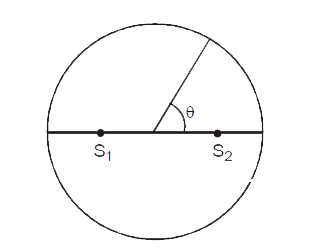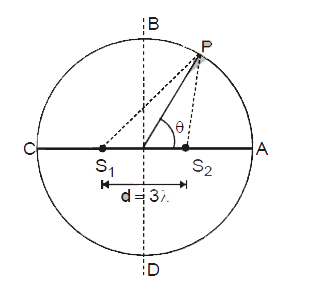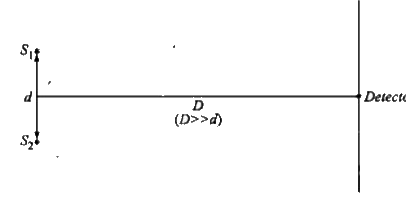Two point sources of sound are placed at a distance d and a detector moves on a straight line parallel to the line joining the sources as shown in figure. At a distance D away from sources. Initially Detector is situated on the line so that it is equidistant from both the sources. Find the displacement of detector when it detects maximum sound and also find its displacement when it detects minimum sound.

The situation is shown in figure

Let us consider the situation when detector move by a distance x as shown. Let at this position the path diference between the waves from to detector by then we have
Here if is small angle as , we have
Thus at the position of detector, path deference is
The expression for path difference in equation (1) is an important formula for such problems. Students are advised to keep this formula in mind for future use. When detector was at point O, path difference was zero and it detects a maxima, now if detector detects maximum then its path difference at a distance x from O can be given as
Similarly if detector detects minima then the path difference between two waves at detector can be given as
.
Similar Questions
Two point sources ofsound are placed at a distance d and a detector moves on a straight line parallel to the line joining the sources as shown in figure-6.27 at a distance D away from sources. Initially Detector is situated on the line so that it is equidistant from both the sources. Find the displacement of detector when it detects nth maximum sound and also find its displacement when it detects nth minimum sound.
 View Solution
View SolutionTwo point sources are d=nλ apart. A screen is held at right angles to the line joining the two sources at a distance D from the nearer source. Calculate the distance of the point on the screen where the first bright fringe is observed. Assume D>>d.
View Solution
Knowledge Check
- Question 1 - Select One
Intensity of sound at a point is its distance from the source
Adirectly proportional toBinversely proportional toCdirectly proportional to square ofDinversely proportional to square of - Question 2 - Select One
A point source of light moves in a straight line parallel to a plane table. Consider a small portion of the table directly below the line of movement of the source. The illuminance at this portion varies with its distance r from the source as
AE∝1rBE∝1r2CE∝1r3DE∝1r4 - Question 3 - Select One
Two sound sources emitting sound each of wavelength λ are fixed at a given distance apart. A listener moves with a velocity u along the line joining the two suorces. The number of beats heard by him per second is
A2uλBuλCu3λD2λu
Is there a Doppler's Effect for sound when the observer or the source move at right angles to the line joining them?
View SolutionTwo sources of sound, S1andS2 , emitting waves of equal wavelength 20.0 cm, are placed with a separation of 20.0 cm between them. A detector can be moved on a line parallel to S_1S_2 and at a distance of 20.0 cm from P it. Initially, the detector is equidistant from the two sources. Assuming that the waves emitted by the sources are in phase, find the minimum distance through wffich the detector should be shifted to detect a minimum of sound.
View SolutionTwo source of sound, S1 and S2, emitting waves of equal wavelength 2cm, are placed with a separation of 3cm between them. A detector can be moved on a line parallel to S1S2 and at a distance 24cm from it. Initially, the detecor is equidistant from the two sources. Assuming that the waves emitted by the sources are in phase, find the minimum distance through which the detector should be shifted to detect a minimum of sound.
View SolutionA point source of light moves ijn a straight line paralel to a plane table. Consider a small portion of the table directly below the line of movement of the source. The illuminance at this portion varies with its distasnce r from the source as
View SolutionA soure of sound of frequency 165 hz is placed in front of a wall at a distance 2 m from it. A dtector is also placed in front of the wall at the same distance from it. Find the minimum distance between the source and detector for which maximum sound is recorded int he detector . the speed of sound is 330 m/s
View Solution

